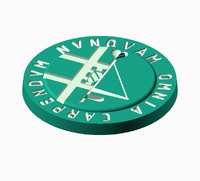PersonalSeal
I wanted a personal seal that would be historically correct in the Middle Ages. I already had one, but after I made it, it turned out to have a few properties that were not period-correct. It had the emblem lying on top of it, instead of being taken away. Also, it had no text. This was to show that, as a medieval craftsman, I could not read or write. However, the sealmaker definitely could, so any seal would have text, unless you wanted to pay so little that text was not affordable.
I want a good seal with text, as most seals in those days were. I admit that most craftsmen would not have a seal, but apart from that I want it to be as historically correct as possible. The text on the edge of the seal would be either a motto, or the name and/or title of the bearer. So city seals, for example, would have the name of the city.
The emblem of the seal is in two halves: one half is a pump drill, drawn half to a centre line. The centre line is denoted with a half-hatched heart, which was the pre-war method of drawing a "heart line". The other half is a mill wheel. The mill wheel is drawn around a wooden axis, which is hatched.
The pump drill is the symbol of the wood- and bone worker in Archeon (my former profession), and the mill wheel is the symbol of the voluntary millers (which I am now). The heart in the line is the love for the technology. Drawing something half against a centre line is what a technical draftsman would do, and that is a one of my former professions also. The motto "NVNQVAM OMNIA CARPENDVM" means "never take everything".
I want to try a new casting technique for making the seal. My original seal was made by making a model in wax and then casting it in sand, but that leaves the sand texture in the model. I want to have a finer grained model now, so I want to try to do a combined ceramic shell and sand cast. The back side is still cast in sand, while the emblem side is cast in a mixture of plaster of Paris and sand. The model is a 3D printed seal, designed in LibreCAD and OpenSCAD, and molten out of the ceramic shell, because the plaster of Paris mixture is so brittle.
